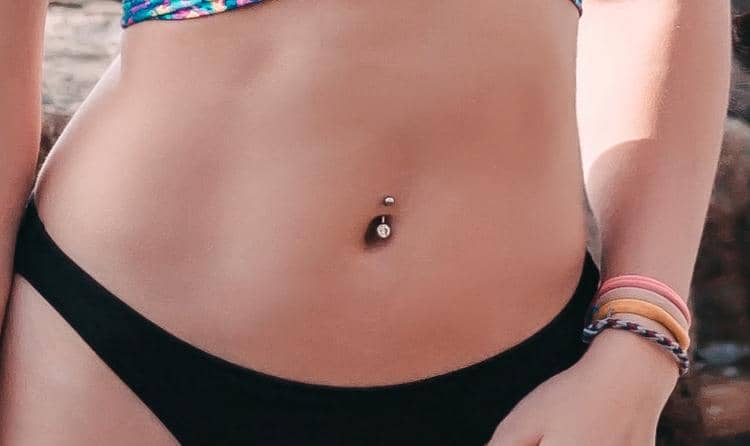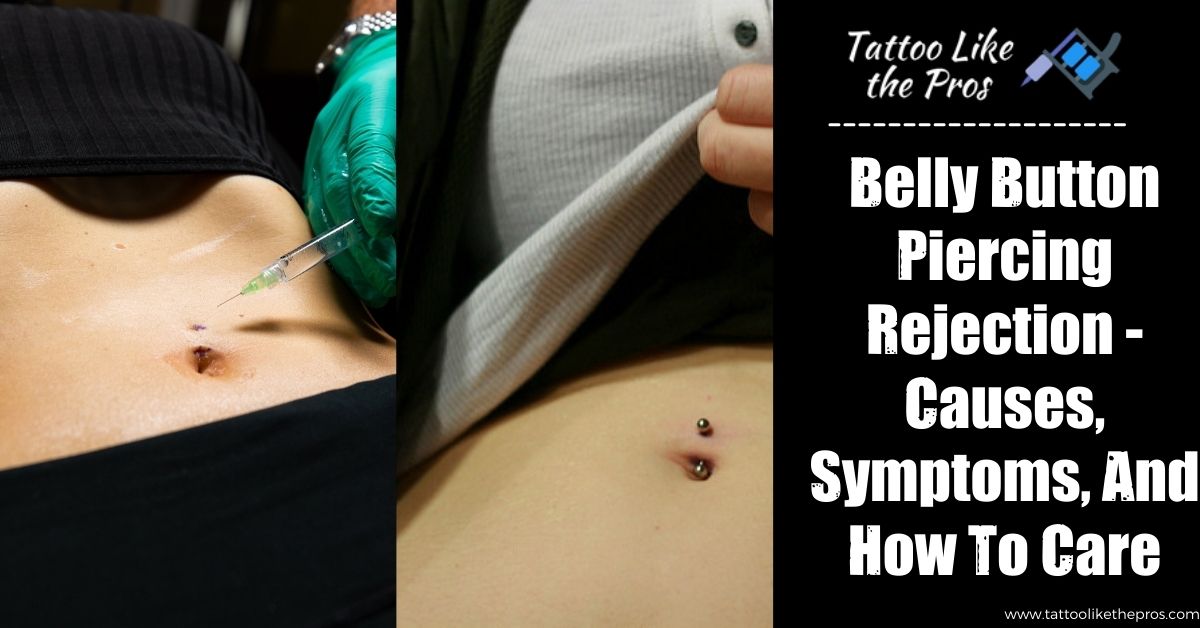Body piercing was a big hit back in the early 2000s. The good news is, it’s fast picking up again. Among the types of body piercings, belly button piercing is a rage these days. However, just like everything else in life, you must be prepared for both the best and the worst. In the case of belly button piercing, there could be a chance — a slim chance — you’ll experience your body trying to push the foreign object out. When that happens, we call it belly button piercing rejection. In this article, you’ll learn why that happens, the symptoms, and how to take care.
I say “slim” chance above because piercing rejection isn’t as common as the other piercing complications. That said, other complications such as dermatitis, keloids, and infections have a higher prevalence rate.
What happens in a scenario of piercing rejection is that your piercing begins to transfer towards your skin’s surface. And, this usually occurs in the early stages of piercing rejection. The consequence of your body naturally pushing the piercing toward the surface of your skin is that ultimately your skin cracks open to let out the piercing.
You must also bear in mind that rejection usually occurs in a flat area of the body. Hence, piercing rejection can happen in piercings of the eyebrow, nape, hip, etc. However, the purview of this article is the piercing rejection that may occur in one of the flattest areas — your belly button.
Here’s all the low down on piercing rejection of the belly button that you should know:
Also Read: The Definitive How to Pierce a Belly Button Guide
What Causes Belly Button Piercing Rejection?

To understand what causes belly button piercing, think of your body’s robust self-defense system. The system continuously, by the hour, protects you from a multitude of potential health hazards. These hazards include, yet aren’t limited to, things like bacteria, germs, fungi, and several types of airborne diseases.
Your skin is the largest body organ. Therefore, it faces full exposure to the outside environment. Further, the skin holds your bodily fluids intact and protects them from infection-causing harmful microbes.
Now, think about the last time you fell on your knees or scratched some other body part. Didn’t your immune system pull into action right away! As a result, your skin got healed ASAP, right? That happens because when your skin experiences an injury, it goes through a natural healing process. That process starts with pain and inflammation but ends with the rebuilding of scar tissue.
Similarly, piercing rejection happens when your body tries to defend itself from a threatening invader, which in this case is your belly button jewelry. Again, because this is surface jewelry, the body pushes out the jewelry instead of forming a wall of scar tissue there.
Here’s why some folks experience belly button piercing rejection while others may not:
- The healing rate is different among individuals due to genetics.
- The size, shape, and material of the jewelry. If your jewelry is not the right fit for the piercing, this can cause migration. Furthermore, you must talk to your piercer to know which jewelry material is suitable for your skin type. For example, if you have sensitive skin, you’re safer with niobium or titanium jewelry.
- Body changes due to pregnancy or weight gain cause the skin to stretch and influence the piercing.
- The effects of stress (emotional and physical) can cause your immune system to be affected negatively. For the piercing results to be positive, you must be in a relaxed state of mind and physique when going for a piercing.
Symptoms of Belly Button Piercing

Although rejection usually happens a few weeks or months after the piercing, it’s not uncommon for it to happen a year to several years later.
To further understand the phenomenon of belly button piercing rejection, you need to know the symptoms. These symptoms represent that your body’s defense system works correctly to protect it from threatening, foreign invaders like jewelry.
Without further ado, here are the main symptoms:
- Your jewelry has shifted from its intended place, and this change is quite noticeable.
- There’s a drastic thinning of the tissue at the entrance and exit holes of the piercing. Typically, the distance between the holes should be about ¼ inch.
- There’s an enlargement of the holes at both the entrance and exit points.
- Your jewelry has begun hanging or drooping unusually.
- The skin is flaky, red, peeling, inflamed, hardened, or transparent between the holes. There could also be puss.
You May Also Like: How to Pierce Eyebrows: A Step by Step Guide
How To Care For Belly Button Piercing Rejection?

When it comes to piercing rejection, there’s isn’t much to worry about other than the scarring that occurs. But, on the other hand, if you experience severe infection, you should rush to your doctor.
To care for the piercing rejection, the best option is to prevent the jewelry from exiting from the skin’s surface. The aftermath of the jewelry cracking open the skin’s surface can be more damaging as it causes excessive scar tissue. If you want to get a re-piercing done at the same site, then extreme scar build-up is what you need to avoid.
To make sure your jewelry doesn’t exit from the skin’s surface during a piercing rejection, here are a few things to bear in mind:
- Remove the jewelry as soon as you notice signs of it migrating towards the skin’s surface. If you keep wearing the jewelry, the scarring may keep increasing.
- Switch to jewelry that is of a different material, shape, weight, and size.
- Aim to reduce the scars by applying topical Vitamin E oil.
- Speak to your piercer for further advice.
- Do not get a re-piercing done until you’ve waited a full year for the skin to heal.
- Trying to treat the rejection with a covering or bandage at home may slow the healing process. Therefore, refrain from doing that type of home treatment.
How To Prevent Belly Button Piercing Rejection?
Many times a piercing rejection leaves us surprised because it happens without any apparent cause. Nevertheless, it’s a good recommended practice to take specific steps that help minimize the chance of it happening.
- To begin with, before getting the piercing, ensure you’ve researched enough to shortlist the best piercers in your vicinity.
- Talk to your piercer about their experience with surface piercing, such as the sterilization and safety measures to do with belly button piercing. Your discussion should include the rejection rate for the belly button of people with a similar skin type as yours. Moreover, it would help if you discussed the depth of the piercing with your piercer and the recommended size of belly button jewelry to wear while the piercing is healing.
- To minimize the chance of rejection, try to get a larger gauge (thicker) piercing. Doing so may reduce the possibility of rejection.
- You need to follow all the recommended aftercare instructions (see next section).
- Soak the area in a saltwater compress, and keep it extremely clean.
- Avoid stress.
- Eat well.
- Stay mentally and physically fit.
- Avoid wearing clothes that are too tight. Tight clothes can irritate the pierced area. The remedy is to wear loose, comfortable clothing.
- Avoid hot tubs, pools, and natural bodies of water like lakes and sea sides. Chemicals, dirt, and bacteria should be kept away to avoid irritation.
Bonus Read: How to Pierce a Nose: Cartilage, Septum, and More!
Aftercare Instructions
Keeping the piercing clean at all times is my number one tip! Doing so helps the healing process and safeguards you against infections.
Furthermore, you should avoid using harsh cleansers. These include antibacterial soaps, peroxide, or alcohol-based products. The rationale behind avoiding these is that they can irritate the skin and delay the healing process.
So, the best method of cleaning the area is by using a sterile saline solution. Alternatively, your piercer can recommend another suitable product.
As a word of caution, ensure not to bump your piercings. An injury to the area is the last thing you should have to put up with, especially during the healing stage. This could cause migration, rejection, and irritation.
Conclusion
The reason we go for piercings is that they look lovely. Like tattoos, piercings, too, are an incredible way to express yourself. But, as explained above, there are some risks associated with piercing. Much like there are with other forms of body art. Fortunately, you can take steps to minimize the chances of migration and belly button piercing rejection. Following a recommended aftercare regimen is one of the ways to ensure you’re en route to a beautiful outcome. Finally, knowing the symptoms and prevention techniques is essential to take timely remedial steps.
